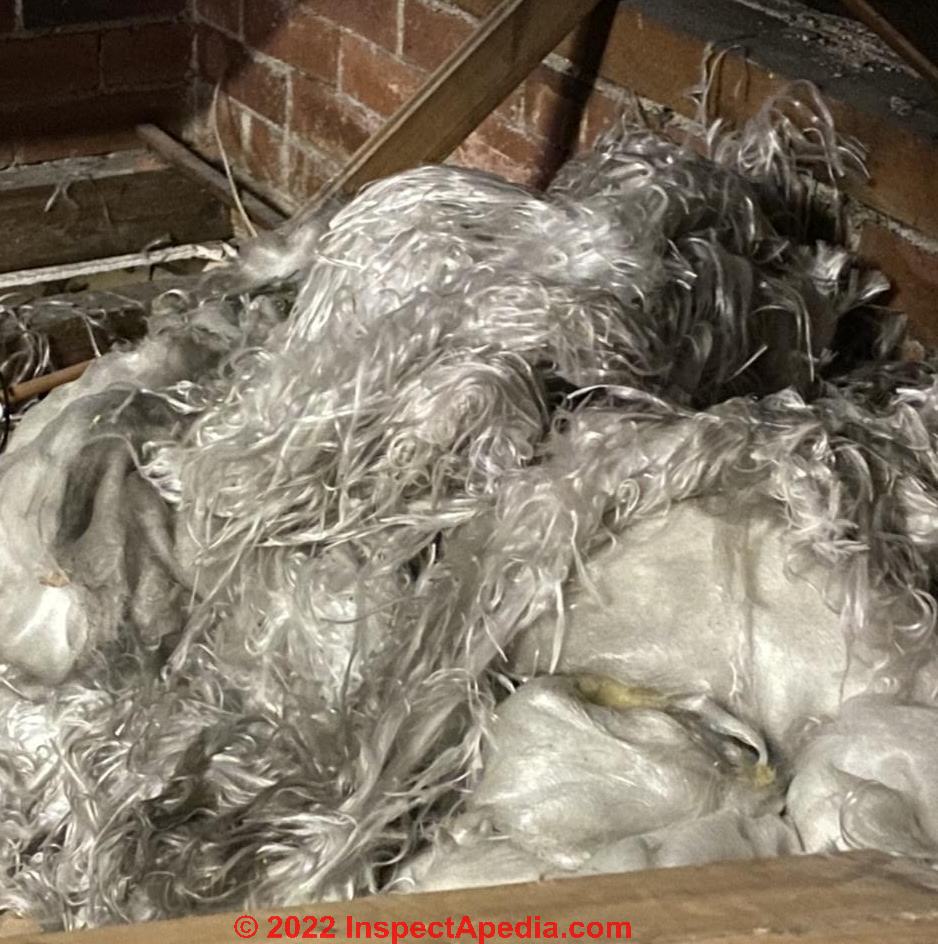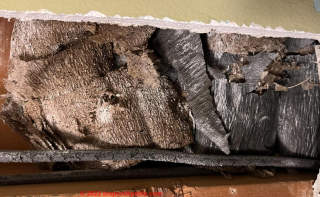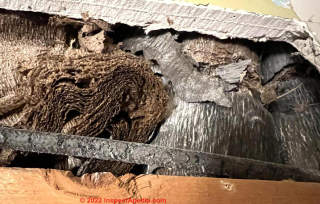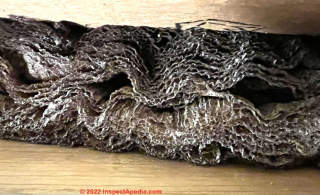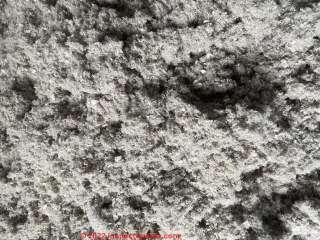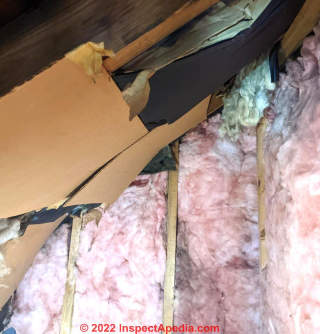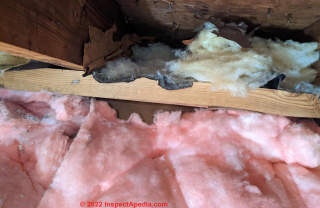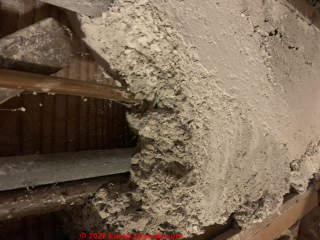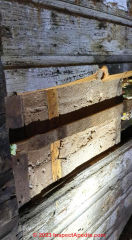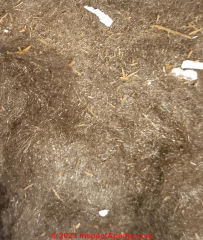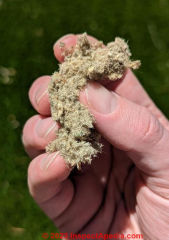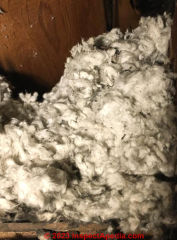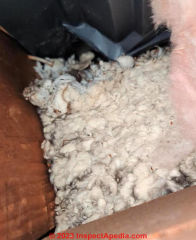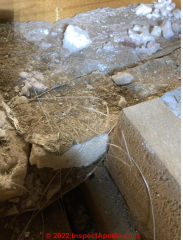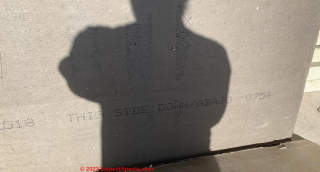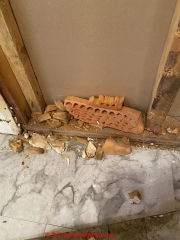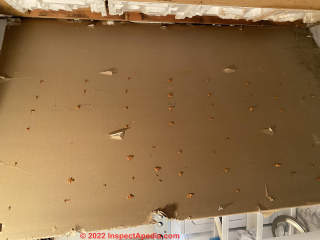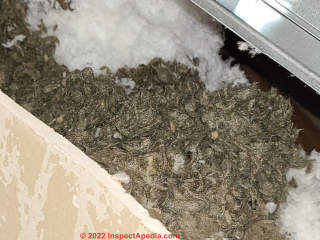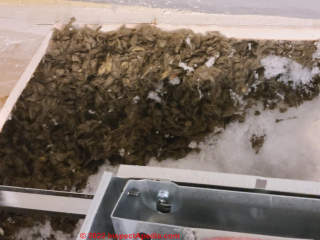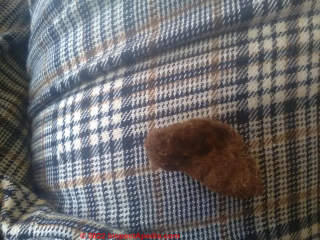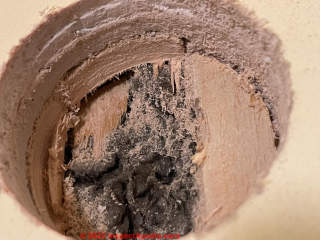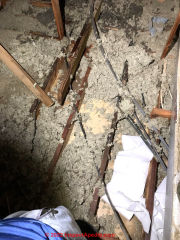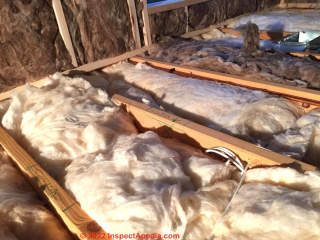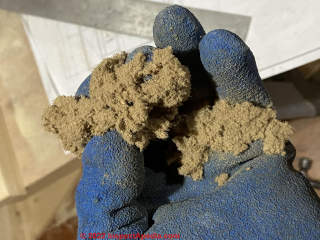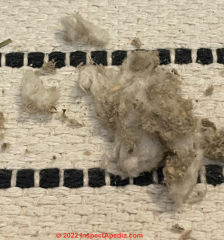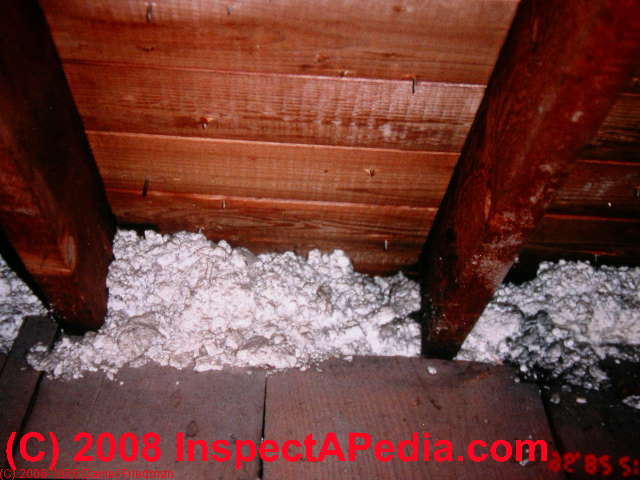 Insulation Identification FAQs
Insulation Identification FAQs
How to identify different building insulating materials
- POST a QUESTION or COMMENT about how to identify different kinds of building insulation
FAQs on how to identify types of insulation used in buildings & their mechanical systems:
This article series provides details about all types of building insulation, identifying each type of insulation.
Page top photo: white mineral wool insulation in an attic.
We illustrate and include photographs of insulation materials that would not be expected to contain asbestos as well as asbestos-containing materials.
InspectAPedia tolerates no conflicts of interest. We have no relationship with advertisers, products, or services discussed at this website.
- Daniel Friedman, Publisher/Editor/Author - See WHO ARE WE?
Q&A on How to Identify Insulation Materials
These questions & answers about identification of various kinds of building insulation by visual inspection were posted originally
at INSULATION IDENTIFICATION GUIDE - be sure to see that article.
[Click to enlarge any image]
On 2022-11-04 by InspectApedia (Editor) - possible vermiculite in 1927 Massachusetts home
@Bill Paulson,
I agree that usually Vermiculite has some shiny particles, is flaky, and varies in color.
"Lumpy dirt" - is a bit baffling though it could be an unusual vermiculite product or even something less common like crumbled cork.
I'd like to see a sample of this material to examine in our lab - if you want to send some contact me by email. (No fee).
On 2022-11-03 by InspectApedia-911
@Bill Paulson,
Your insulating material is a bit dark but a reasonable guess is Vermiculite building insulation.
See VERMICULITE INSULATION for comparison
Are the particles quite light-weight?
Are they varied in color?
On 2022-11-03 by Bill Paulson
Found insulation that even home inspector didn’t recognize. 1927 single fam in Massachusetts. The insulation was in the attic among the floor joists covered by fiberglass. It looked like lumpy dirt.
I would have thought vermiculite but it didn’t have the shine. I have attached a picture. We grabbed a handful and put it on some carpet in the attic.
On 2022-11-01 by InspectApedia-911 (mod) - synthetic fiber insulation
@Yorkshire,
Could be fibreglass, though it does look a lot like a synthetic fiber.
What are the
- building age and location (country - city)
- probable insulation age
- any imprint on any facing on the insulation's other side?
Is it in fact building insulation? Where and how extensively was it used?
If you have a sample of the material I'd like to look at in our lab - let me know. (No fee/costs involved).
On 2022-11-01 by Yorkshire
Stumbled across this stuff in a loft, never seen anything like it. Any ideas?
On 2022-10-29 by Jessica
@InspectApedia (Editor), Thank you so much! Glad I’m not dealing with something hazardous.
On 2022-10-27 by InspectApedia (Editor) (mod) - old and crumbling crepe paper insulation
@Jessica,
We'll add your crepe insulation photos at KRAFT PAPER INSULATION CREPE KIMSUL
PLEASE HELP us out by telling me the age and location of your building where this insulation was used.
On 2022-10-27 by InspectApedia (Editor) (mod) - craft or crepe paper type insulation.
@Jessica,
That's a craft or crepe paper type insulation.
That insulating material is still sold, more-likely for use in packaging, such as the Versa-Pak™ Cellulose Wadding shown below.
That's a plant-based (cellulose) or "paper" material.
Thank you for a helpful photo and question.
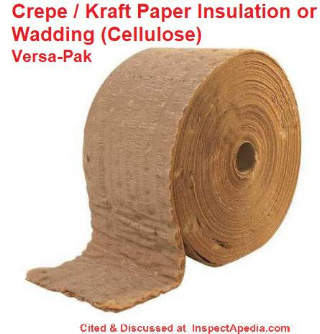
On 2022-10-27 by Jessica
On 2022-10-27 by Jessica
Hi! I wondered if you might be able to help identify this.
We opened up a wall and found this very fragile insulation. It’s layered and basically disintegrating when touched. It seems to be rolled up in small sections. I haven’t been able to find anything that looks similar to it.
On 2022-09-27 by InspectApedia (Editor) - cellulose insulation
@Bob,
You posted this question and we replied at InspectApedia, https://inspectapedia.com/insulation/Cellulose_Insulation.php.
It'd be great if you'd add your remaining photos there
Please post on just one page - we have thousands of readers - double posting halves our ability to respond.
On 2022-09-25 by Bob
Hello. I had a plaster ceiling falling down in our bedroom. I demo’d most of it. Our house was built in the 1920’s. It’s odd because there are nominal joists above the room, with hemp/jute sheets stapled to them. Above that is some sort of blown in or loose insulation .
There was a brand new air conditioning/ heating system installed throughout the entire house in 2020 before we bought it. Ducts were cut in around this stuff. I’m trying to identify this insulation. Which came crashing down with the ceiling…
On 2022-09-19 by InspectApedia-911 (mod) - Brittle and black paper backed fiberglass insulation
@James,
That looks to me as if there's pink fiberglass on a wall and a white mineral wall insulation overhead. Those are not asbestos products. There was asbestos in some saturated felt papers such as the black tar paper like material in your photo.
On 2022-09-18 by James
Have some batting falling down in the eaves. Brittle and black paper backed. Silver/gray look. I've cleared out the stuff that has fallen, my thought was it was fiberglass, but hoping for any info you might have.
On 2022-08-25 by InspectApedia-911 (mod)
@Paula,
That could be ASBESTOS PIPE INSULATION
We could be more helpful and research more thoroughly and more quickly to give a more useful answer if you would help us out first with a bit of very basic information.
Otherwise, flying blind, we can be stuck in a game of stump the chump. Which is not difficult to do.
Basic information includes things such as:
Location: Country and city of location, where the object of your question was found. Our readers are in 52 countries around the world.
Surrounding context: By context I mean information such as history of a site or a building or name and (if known) age of site or building where an object that is the subject of a question has been found.
On 2022-08-25 by Paula
I need help identifying this insulation. It’s only between the stores that have pipes. It looks like it’s soft but I don’t wanna touch it.
On 2022-08-25 by InspectApedia-911 (mod) - What type of insulation is blocky and crumbley and dark orange?
@Brian,
UFFI, urea formaldehyde foam insulation
On 2022-08-25 by Brian
What type of insulation is blocky and crumbley? Color was dark orange, brownish red tint too. Almost blocky in shape but also like caged animal bedding.
I was checking my fire alarm in my apartment and it fell down in chunks from the hole. I already cleaned it up and don't want to open it again Incase of asbestos. Any guesses?
House was built in 1900, remodeled in 1950 according to online. Location is Maine.
On 2022-07-31 by InspectApedia-911 (mod) - chopped newsprint in cellulose insulation
@John G,
It looks like cellulose insulation. Look very closely at your photo and you can actually see some chopped bits of newsprint.
There may be something else mixed in with it.
On 2022-07-31 by John G
What type of insulation is this?
[Photo above]
On 2023-12-10 by InspectApedia Publisher
@Anonymous,
Thank you. Yours is a helpful and important contribution.
On 2023-12-10 by Heather
@InspectApedia Publisher, thank you! I will post photos when I open the opposite wall. It might be a few months before I get around to working on that side of the house, though.
I'm planning to send in a sample for asbestos testing before opening the opposite side of the wall, of course.
Thanks again!
On 2023-12-09 by InspectApedia Publisher
@Heather,
I agree that it'd be odd to try to fill a wall cavity with hard plaster (though we've recently had readers contribute photos of plaster-filled paper bags that appeared in wall cavities as insulation).
There has been a succession of blown-in insulation products - yours may well be one of those. A closer look at the interior side of the insulating material to see if, where wall board or whatever has been removed to expose the wall cavity, you see that the surface of the material maps just the wallboard that you removed, and if it flows very thoroughly into the wall cavity, it may be a retrofit pumped-in lightweight concrete or insulating foam.
Take a closer look and see if you can post some sharp photos - one photo per comment so use more comments if needed -
On 2023-12-09 by Heather
@InspectApedia Publisher, nope, the house was wood sided. This material does have a lot in common with plaster, but it fills the entire stud bay. The interior finish is plaster, but I can't imagine the base coat filled up the entire wall...
On 2023-12-09 by InspectApedia Publisher (mod) - hard, sandy, crumbly material looks like cementious insulation
@Heather,
I can't see any vermiculite in that photo; it looks cementious - like plaster or cement. Was the original home exterior stucco?
On 2023-12-09 by Heather
This is a hard, sandy, crumbly material found inside what used to be the exterior wall of a house built in 1900. My guess: vermiculite? I can't be sure, though. It doesn't seem to match any of the insulation types I've seen on this site.
Thanks in advance!
On 2023-04-20 by InspectApedia Publisher
@Amanda,
You're most welcome.
Your questions as well as any content criticism or Suggestions help us as well.
On 2023-04-20 by Amanda
@InspectApedia Editor , Thank you!
On 2023-04-20 by InspectApedia Editor - water-damaged, crumbling fiberboard insulating sheathing found in 1960s home
@Amanda,
That sure looks like water-damaged, crumbling fiberboard insulating sheathing - not normally an asbestos-containing material.
Take a look at
SHEATHING, FIBERBOARD https://inspectapedia.com/structure/Fiberboard_Sheathing.php for details about insulating sheathing used on both the exterior (under siding) and interior of buildings.
Also see FIBERBOARD SHEATHING IDENTIFICATION https://inspectapedia.com/structure/Fiberboard-Sheathing-Identification-Key.php
In that article series you will read that there were a few odd instances of asbestos-contaminated fiberboard - not something that's a common worry.
On 2023-04-20 by Amanda
Hello, I am wondering if you could advise us this is likely an asbestos containing material? Found in small hole at base of a shower surround in early 1960’s home.
On 2022-11-21 by InspectApedia (Editor) - brown batts in UK home survey called "fibre wool loft insulation" and looks like mineral wool
@EhV,
UK Fibre Wool insulation?
I looked at your photo but on zooming in things are a bit blurry so I can't be sure what I am looking at.
I suspect that what you have called fiber wool insulation is another name for mineral wool that you will find described in this article series. You may also see the phrase rockwool.
On 2022-11-21 by EhV
Hello, we have a brown material laid in batts between the joists in our UK home. It is dark brown and doesn't seem to produce any loose fluff anywhere. The house was built around 1984.
There is a lot of debris and sawdust settled on top. A home survey called it "fibre wool loft insulation". Could you please help me identify the material ? Photo is taken with flash
On 2022-11-21 by InspectApedia (Editor)
@Al,
Yes, exactly, good going.
Much cellulose insulation is made from chopped up newsprint.
On 2022-11-21 by Al - Perth Australia cellulose insulation
I can see writing on parts of this loose fill insulation in Perth l, Western Australia. Would thag mean it's most likely recycled cellulose?
On 2022-11-08 by InspectApedia (Editor)
@Harrison,
Looks like mineral wool
On 2022-11-08 by Harrison
Wondering if you can help identify this insulation. Asbestos is the concern.
On 2022-01-21 by Inspectapedia Com Moderator - 1938 Massachusetts home with mix of mineral wool and fiberglass insulations
@Edward,
Hop over to INSULATION IDENTIFICATION GUIDE - topic home
https://inspectapedia.com/insulation/Insulation-Identification-Guide.php
and there compare your insulation with mineral wool photos and with chopped fiberglass photos. On that page you'll also find links to more-detailed insulation pages that offer more identification photos of each insulation type .
On 2022-01-21 by Edward
I have a house in Milton Massachusetts built in 1938, a 2 story colonial with a finished attic. The attic was finished long ago, the walls and ceiling in the attic are all something similar to Beaverboard.
While my roofers were installing ventilation baffles and pink fiberglass batts between the knee wall rafters, they saw additional loose insulation above the finished ceiling that was originally held back by wooden blocks between the rafters.
It looks like a white / grey wool or cotton ball like substance that comes in small loose clumps. What could it be?
On 2021-04-24 by danjoefriedman (mod)
Matt:
Thank you for posting the "not asbestos" lab test result for what turned out to be 1990s insulated chimney insulation material.
Please find your recently-posted comments the top of
ASBESTOS REMOVAL, WETTING GUIDE inspectapedia.com/hazmat/Asbestos_Wetting_Procedure.php
You may need to clear or refresh your browser cache to see the updated page. We welcome your further photos, comments, questions.
On 2022-05-18 by Friedmandaniel911 (mod)
@Nardia,
If you poke the insulation or squeeze it, does it crumbling into a fine power?
If so, it's probably UFFI.
On 2022-05-18 by Nardia
Hi can someone please advise what type of insulation this may be and or whether it’s safe material or needs replacing due to it starting to disintegrate and turn into powder substance? I’m in Australia if that makes a difference to what it may be. It looks like some type of polystyrene sandwiched between silver foil, polystyrene sandwiched between silver foil.
On 2022-05-09 by Inspectapedia Com Moderator
@Brock,
Mineral wool or rock wool
On 2022-05-09 by Brock
Trying to identify this insulation is on my attic floor in a crawl space it's looks like balled fibers.
On 2022-05-03 by Inspectapedia Com Moderator
@Garland,
See if you can make out a UPC number on the board and then use an online UPC lookup - that will ID the manufacturer and product.
On 2022-05-03 by Garland
I have some 3” board insulation from a Ford dealership. I can’t find the manufacturer or r value. Can someone give me information on this?
On 2022-04-28 by Inspectapedia Com Moderator
@Robert, scraping?
See the mineral wool and rockwool photos and identification links on this page
On 2022-04-28 by Robert
Interior wall fill, likely from the 1950-1970s, New Jersey, USA. Dark grey, wool like, brittle, compresses easily. Similar to lose steel wool. Needs to be removed for inspection, planning on having it wetted slightly and pulled out. Need to know the type of insulation safe to remove?
On 2022-04-19 by Inspectapedia Com Moderator
@80's foam board insulation,
If it's fibrous it may be described at FIBERBOARD SHEATHING
If it's really a foam product then see FOAM BOARD INSULATION TYPES
On 2022-04-18 by 80's foam board insulation
Hi my 80s house has 2x4 exterior walls without sheathing. There is some type of foam-board insulation directly nailed to the studs. I can't find any product or manufacturer info on the product. I'd love to identify what type of product or even brand this is.
It's 1" thick, light brown/orang in color with a reflective thing metal type outer layer. It's pretty brittle.
On 2022-04-10 by Inspectapedia Com Moderator - sample requested of perforated foam board insulation
@Nicole L.,
I would like to see a sample of this insulation in our forensic lab. If you're willing to mail a couple of cubic inches of the material in a clean freezer-type ziploc bag, contact me by email using the page top or bottom CONTACT link.
On 2022-04-09 by Inspectapedia Com Moderator
@Nicole L.,
Sure - easier to do now that I'm back in our lab.
All of the insulation types and articles are in the INDEX to RELATED ARTICLES: ARTICLE INDEX to BUILDING INSULATION -
found at the Recommended Reading section on this page
FIBERBOARD SHEATHING IDENTIFICATION
I must say that I'm not familiar with that material in your photo showing regular holes, and would like to see a sharp close-up.
Is it foam rubber or is it fiberboard or something else?
Was that the main insulating material in your walls - in large segments or was that a random scrap of something?
For comparison see
FOAM BOARD INSULATION TYPES
FOAM INSULATION IDENTIFICATION
Tell us the country and city of location of the building and its age.
On 2022-04-09 by Nicole L.
@Inspectapedia Com Moderator, Thanks! I'm not finding it, could you post the link?
On 2022-04-09 by Inspectapedia Com Moderator
@Nicole L.,
Looks like some type of foam and some type of fiber board. We'll find those described in our index to related articles or by searching the site
On 2022-04-09 by Nicole L.
Asbestos? Demo'ing basement, and also found drywall that appears to have old insulation removed from the back, perhaps was Asbestos? Why would they take the Asbestos off but not replace with new piece of drywall?
On 2022-03-26 by Inspectapedia Com Moderator
@Kathy,
I'm not sure what kind of insulation was installed nor what was banned but I'm guessing that you refer to an asbestos concern such as Vermiculite insulation in an attic.
I expect that you had or should have had a home inspection prior to purchase, and perhaps that informed you of this potential hazard.
Just how serious is the need for "fix" depends on the actual risk that asbestos dust from the insulation can enter the occupied space. If that risk is found significant, then you'd need to hire an asbestos abatement company to remove the old insulation, HEPA-vacuum and clean the area, then an insulation contractor to install new insulation in that same space.
On 2022-03-26 by Kathy
Insulation in recently purchased home was installed in 1981 and banned in same year. How do we get this fixed?
On 2022-03-12 by Inspectapedia Com Moderator - mineral wool examples
@Kdub,
See our examples of Mineral Wool above on this page
On 2022-03-11 by Kdub
Opened the ceiling of a 1974 Central TX home and dragged this all over the house, do I need to (can I even?) remediate? Currently running HEPA filters and crossing fingers. Thanks for any input.
On 2022-02-23 by Inspectapedia Com Moderator
@Belinda,
A clump of brown fibrous material sitting on a plaid fabric. I can't see clearly enough to be certain if it's a balsam-wool product or something else.
When you as a "what is this" question, giving us even a little bit of surrounding information would be most helpful.
What are the country and city of location?
Where was the material found?
Is there more of it, in situ, or is the little clump in your sample 100% of what was observed?
If the latter, how did it come to be sitting on a bit of plaid fabric?
If it is believed to come from a building, what is are the age and location of the building and from what suspected source: building insulation, appliance, animals, something else?
On 2022-02-23 by Belinda
What is this
On 2022-02-22 by Inspectapedia Com Moderator - fiberglass insulation over rainwater pipe in Spain
@Jesúa Vicente,
Gracias. Me alegre oirlo. Trabajamos mucho sobre este información para hacerlo util y preciso. Por eso nos gusta mucho oir que podiamos ayudarle.
Tambien sus preguntas nos ayudan.
On 2022-02-22 by Jesúa Vicente
@Inspectapedia Com Moderator, Muchas gracias por su información. Me ha sido de gran utilidad !
On 2022-02-21 by Inspectapedia Com Moderator
@Jesúa Vicente,
The yellow material is fiberglass
Estas bienvenido escribir en el español tambien.
On 2022-02-21 by Jesúa Vicente
Hello.
The material in the photograph is covering a rainwater drainage pipe. It is in a building built in 2001 (Spain).
I would like to know if it can contain asbestos
I'm sorry for the grammar. I am using a translator Thanks a lot.
On 2022-02-02 by Inspectapedia Com Moderator
@wdstack,
Take a look at the mineral wool photos in this article series
On 2022-02-02 by wdstack
Hi folks, I'm installing a through-wall chimney for a wood stove in our 1890/1920s house. Drilled a 2-inch hole in the wall to get started, and this was behind the lath. Any idea what this soft, gray stuff might be?
On 2022-01-28 by Inspectapedia Com Moderator
@Richard Bergquist,
Compare your insulation to the photographs and description of cellulose insulation found in the article above
On 2022-01-28 by Richard Bergquist
Any risk this insulation is asbestos?
On 2022-01-23 by Inspectapedia Com Moderator
@Devin,
Start by identifying the type of insulating material itself, which you can do by screening through the photos above all this page.
When you've chosen an insulation that looks most like yours you'll find here a link to detailed pages that list manufacturers of those products.
On 2022-01-23 by Devin
Any idea what kind or brand makes this type of insulation? It’s very good sound deadening.
On 2022-01-19 by Inspectapedia Com Moderator
@Christopher,
Thank you. We can see why this topic would be of particular concern to you.
We've worked hard on this material for decades, so are really grateful when a reader finds it useful and trustworthy.
We also welcome your photos, questions, criticism or suggestions.
On 2022-01-19 by Christopher
Again, I am grateful for your opinion.
A close family member was diagnosed with mesothelioma of the stomach. Sense then whenever I encounter the possibility of being in contact with it, my anxiety clouds my judgment.
Thank you for your time..
On 2022-01-19 by Inspectapedia Com Moderator - clues to identifying cellulose
@Christopher,
That sure looks like loose fill or blown-in cellulose - a paper product. Sometimes you can find tiny bits of actual newsprint in the insulation: look at the larger fragments with a magnifying glass if you like.
On 2022-01-19 by Christopher
Most grateful for your response. I have attached a more clear photo.
Understanding that there is almost no way to accurately identify if this insulation has aspestos via a photograph, I very much appreciate your hypothesis. This is my final comment about this job site. Thanks again, Christopher
On 2022-01-19 by Inspectapedia Com Moderator
@Christopher,
A bit blurry photo so I'm unsure, but try comparing your insulation to the mineral wool photos on this page and in the article of more detail whose link you'll find on the page above.
Also compare with cotton insulation and with vermiculite.
On 2022-01-18 by Christopher
Renovating an old home built with old rough sawn 2x stock. The wall bays are filled with old paperback pink fiberglass.
But the bays in the 2nd for ceiling joists/attic space is filled with yellowish powdery insulation. It doesn’t feel itch to the touch so I’m thinking it’s not chopped fiber glass.
It could be old cellulose but I’m use to seeing it be more Grey in color and not so fine in texture.
Can you tell me if this material is likely to have asbestos in it?
Thank you for your time.
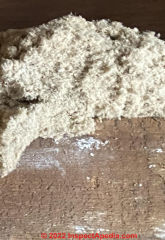
On 2022-01-15 by John Smith
@Inspectapedia Com Moderator,
Thanks so much! That's what I thought as well.
On 2022-01-15 by Inspectapedia Com Moderator
@John Smith,
Looks to me like two different generations: chopped mineral wool and chopped yellow fiberglass insulation
On 2022-01-15 by John Smith
Would you be able to identify this insulation type?
On 2022-01-08 by Inspectapedia Com Moderator
@Oli,
I can't see enough in your photo to be certain, but that looks like either white fiberglass or mineral wool. If you see small wood fragments, it may be that your insulation was near insect infestation or something else that produced sawdust.
On 2022-01-08 by Oli
Could you identify this please? Looks like cellulose mixed with some white softer (fibreglass??) insulation
...
Continue reading at INSULATION IDENTIFICATION GUIDE - topic home, or select a topic from the closely-related articles below, or see the complete ARTICLE INDEX.
Or see INSULATION IDENTIFICATION by COLOR / TEXTURE FAQs - more photos and identification Q&A on insulation identification
Or see these
Recommended Articles
- FOAM SPRAY INSULATION TYPES
- INSULATION IDENTIFICATION GUIDE - home
- INSULATION IDENTIFICATION by COLOR / TEXTURE FAQs
- INSULATION INSPECTION & IMPROVEMENT inspecting and improving the level and effectiveness of insulation in buildings, advice on troubleshooting insulation problems.
Suggested citation for this web page
INSULATION IDENTIFICATION GUIDE FAQs at InspectApedia.com - online encyclopedia of building & environmental inspection, testing, diagnosis, repair, & problem prevention advice.
Or see this
INDEX to RELATED ARTICLES: ARTICLE INDEX to BUILDING INSULATION
Or use the SEARCH BOX found below to Ask a Question or Search InspectApedia
Ask a Question or Search InspectApedia
Try the search box just below, or if you prefer, post a question or comment in the Comments box below and we will respond promptly.
Search the InspectApedia website
Note: appearance of your Comment below may be delayed: if your comment contains an image, photograph, web link, or text that looks to the software as if it might be a web link, your posting will appear after it has been approved by a moderator. Apologies for the delay.
Only one image can be added per comment but you can post as many comments, and therefore images, as you like.
You will not receive a notification when a response to your question has been posted.
Please bookmark this page to make it easy for you to check back for our response.
IF above you see "Comment Form is loading comments..." then COMMENT BOX - countable.ca / bawkbox.com IS NOT WORKING.
In any case you are welcome to send an email directly to us at InspectApedia.com at editor@inspectApedia.com
We'll reply to you directly. Please help us help you by noting, in your email, the URL of the InspectApedia page where you wanted to comment.
Citations & References
In addition to any citations in the article above, a full list is available on request.
...
- Carson, Dunlop & Associates Ltd., 120 Carlton Street Suite 407, Toronto ON M5A 4K2. Tel: (416) 964-9415 1-800-268-7070 Email: info@carsondunlop.com. Alan Carson is a past president of ASHI, the American Society of Home Inspectors.
Thanks to Alan Carson and Bob Dunlop, for permission for InspectAPedia to use text excerpts from The HOME REFERENCE BOOK - the Encyclopedia of Homes and to use illustrations from The ILLUSTRATED HOME .
Carson Dunlop Associates provides extensive home inspection education and report writing material. In gratitude we provide links to tsome Carson Dunlop Associates products and services.



